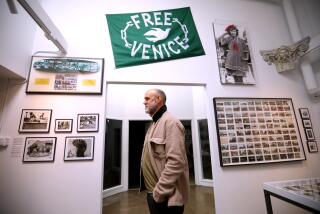World Perspective Reflected in Glass
- Share via
SAN DIEGO — Glass may be fragile, but that has not kept it from enduring, as can be seen in an exhibition at the Mingei International Museum in Balboa Park. “Venini Glass and Design--in a World Perspective” focuses on 70 Italian Venini glass objects from 1920 and surrounds them with an array of objects in the medium from throughout history, dating back as far as Mesopotamia, Egypt and ancient Rome.
“We wanted to put a context to the Venini glass pieces by showing where glass has come from and where we are today with it,” says Rob Sidner, assistant director of the Mingei. “There is such richness and variety in this amazing medium.”
The first rudimentary glass is thought to have been invented in Mesopotamia about 5,000 years ago. “Glass is both sturdy and delicate,” explains Sidner. “That these pieces have been loved so much through the ages to reach us at this far distance is a sign of how treasured they were.”
The show includes more than 30 pieces borrowed from the Corning Museum in Corning, N.Y., which is famous for its glass holdings. It begins with examples of core-formed glass likely developed in Egypt or Mesopotamia around 1650 BC.
“Glass wasn’t blown yet; instead, it was formed around a core to give shape to it,” Sidner says. Core-formed vessels were very popular and continued to be made for more than 15 centuries.
The first blowing of molten glass probably occurred in Syria in the middle of the 1st century BC, and examples from that period can be seen in the show. Venice emerged as a world power in the 13th century, and its glass industry began by using techniques brought from Syria and Damascus; glass works have been made since the late 14th century on the island of Murano in Venice.
Early Venetian glass also can be seen here, as well as European glass from the 17th, 18th and 19th centuries. There are colorful golden Bohemian pieces, sturdy German and Dutch beakers, fanciful etched English glass and a whimsical shadow box from France combining glass and seashells. There are oversized margarita glasses from Mexico, traditional roped fishing floats from Japan, Chinese snuff bottles and a dark brown American carboy--or large jar--originally used to transport molasses.
One section of the show features American glass, with a particularly resplendent Art Nouveau lamp and a Jack-in-a-Pulpit vase by Louis Comfort Tiffany. There are also art glass works by Benjamin Moore, who studied at Venini in the 1960s and ‘70s, as well as pieces by Seattle artist Dale Chihuly. Utilitarian pieces include a cut-glass American punch bowl and cups, etched glass by Heinrich Wilhelm Stiegel (1729-85) of Pennsylvania, etched bottles and cut crystal vases and candelabras.
The Venini portion of the exhibition was curated by Anna Venini, daughter of Paolo Venini (1895-1959), and by the Mingei Museum, San Francisco’s Museo ItaloAmercano and the Italian Cultural Institute of Los Angeles.
“Paulo Venini, a lawyer from Milan with a passion for glass, founded his glass factory in 1921 with Venetian Giacomo Cappellin on Murano,” says Sidner. They worked with international designers from throughout the world, not just Venetians. “Glass design in Venice had gotten pretty stodgy, hide-bound and kitschy over the centuries. Venini revolutionized Venetian glassmaking in a short space of time.” Many experts consider Paulo Venini the greatest name in modern Italian glass.
Although the partnership dissolved in 1925, Venini continued running the business and attracted designers such as Vittorio Zecchin, Carlo Scarpa and Fulvio Bianconi. Their innovative designs turned the glass design world on its ear, says Sidner. Examples of their work, as well as pieces by Venini family members, are also on view.
“These glass pieces remind us that we need to be attentive to what we live with. These things are beautiful because people couldn’t help it. They come out of our basic human creativity, that response to beautify what we use in our daily lives,” concludes Sidner.
*
Mingei International Museum, Balboa Park, San Diego, open Tuesday through Sunday, 10 a.m.-4 p.m. Call (619) 239-0003.
More to Read
The biggest entertainment stories
Get our big stories about Hollywood, film, television, music, arts, culture and more right in your inbox as soon as they publish.
You may occasionally receive promotional content from the Los Angeles Times.










